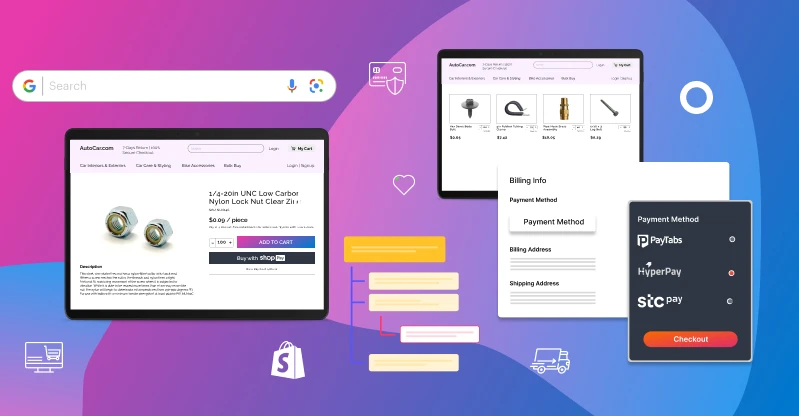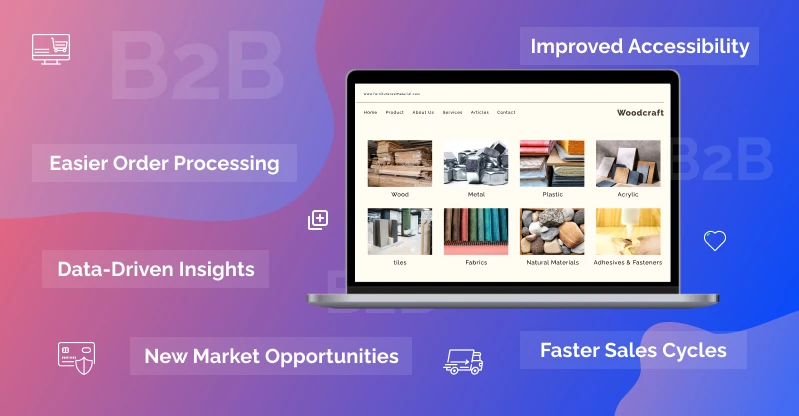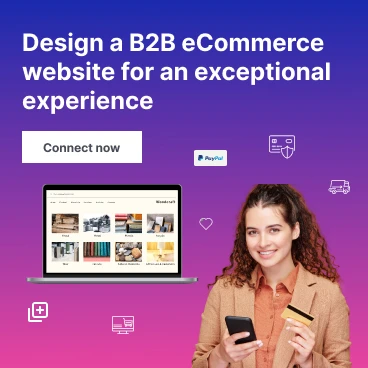Creating a B2B eCommerce Website with Exceptional User Experience

In today’s digital world, developing an intuitive experience is equally important for B2B as for retail customers. In the B2B industry, many people use mobile devices and shop online, so the end-users expect the same user-friendly features in their business purchases.
According to a recent survey, global B2B eCommerce is worth $2 trillion, and 83% of B2B buyers make daily online purchases. Therefore, it’s important to develop a user-friendly and intuitive website for the B2B consumer. It can majorly impact the b2b sale in this digital world.
A seamless online experience can also help b2b owners stay unique in this competitive world. Therefore, it’s mandatory to create a simple and engaging website to drive a positive purchase experience for your b2b clients.
This guide demonstrates how a strong B2B eCommerce platform and a well-designed website can improve the buyer experience while also increasing the efficiency of backend operations.
Key Element That Impacts B2b eCommerce Website
While developing a b2b eCommerce website, the business owner needs to consider a few key elements. Let’s explore them below:
User-experience
User experience (UX) refers to how a website interacts with its visitors. Similarly, to b2c, Offering a customized experience is crucial for b2b. This demands utilizing distinctive designs, excellent visuals, user-friendly navigation, and useful tools that enhance the purchasing experience.
A well-designed B2B eCommerce website can increase sales, improve customer relationships, and simplify purchases.
According to Gartner, 80 percent of business-to-business transactions will take place online by 2025, underscoring the necessity of an eCommerce website that is optimized to stay competitive.
Therefore, when selecting a platform, it’s critical to concentrate on UI/UX design, mobile optimization, and seamless checkout procedures.
A simple, intuitive website is the foundation of a great user experience. Here are some essential methods to accomplish this:
Maintaining Consistent Branding
Ensure that your brand is consistently represented on every page, including the homepage, product listings, and checkout.
The Navigation Is Intuitive
Logical and easy navigation makes it easier for visitors to explore your website, lessens frustration, and increases engagement.
Design Support Specific to Platforms
By utilizing B2B-focused themes available through eCommerce web development platforms, where you can create designs that are both aesthetically pleasing and easy to use.
Pay Attention to Performance and Speed
Speed is crucial for business-to-business purchasers. According to studies, 60% of them abandon a website that loads slowly. Therefore having a fast highly performed website is the key necessity. Let’s take a look below on how the b2b website speed can be increased.
Check Core Web Vitals
To identify areas that require improvement, periodically review your performance metrics using Google Core Web Vitals. A high Largest Contentful Paint (LCP) score, for instance, can indicate that videos or images are loading slowly. The user experience can be significantly enhanced by making them smaller.
Select a Trustworthy Platform
Select a reliable eCommerce platform to maintain the functionality of your website. It’s important to find a reliable platform that provides robust performance and uptime guarantees. This implies that even during peak periods like holiday sales or promotions, your website will remain quick and accessible. You can increase customer satisfaction and reduce cart abandonment rates by emphasizing speed and performance.
Make Your Devices Mobile-Friendly
80% of B2B buyers want better mobile experiences, so having a mobile-optimized website is crucial. A seamless and consistent user experience across all devices is guaranteed by a mobile-first design.
Conversion rates and customer satisfaction are increased by this enhancement. Select an eCommerce platform that provides responsive themes that adapt to mobile screens automatically in order to accomplish this.
Brands can differentiate themselves in a crowded market by offering a smooth user experience across all platforms. Since many business-to-business (B2B) buyers are searching for better mobile shopping options, mobile optimization is essential.
By concentrating on this, businesses can draw in more customers who prefer to make purchases on their phones, increasing conversion rates. By developing mobile-responsive themes through its B2B Edition, brands can transform their desktop stores into customer-focused, mobile-friendly experiences by working with an eCommerce expert.
Ensure Easy Product Search and Discovery
Any eCommerce website must have a robust search feature because B2B customers want to locate products fast. Arrange products into easily navigable, distinct categories to aid customers in finding what they wish to buy. It is easier for customers to find what they need when there are strong filtering options available, such as price, size, or color.
Additionally, by offering tailored product recommendations and clever display techniques, AI solutions from businesses like Klevu can enhance the search experience. B2B businesses can significantly increase customer satisfaction and sales by concentrating on straightforward product search and discovery.

Streamline the Checkout Process
Reduced cart abandonment in B2B eCommerce is largely dependent on a seamless checkout process. Installing a one-click checkout option will help with this. With just one click, customers can now save their shipping and payment information for future purchases. This raises customer satisfaction and accelerates the purchasing process.
It’s also critical to provide a variety of payment methods to satisfy customer needs. The checkout process should be associated with multiple payment options like credit cards, bank transfers, paper checks, and purchase orders as forms of payment. This will allow all buyers to complete their transactions with ease.
Customize the checkout process for each type of seller because B2B purchasing journeys are different. Examples of this are standard shopping carts and more sophisticated features like bulk buying, invoicing, and custom ordering. This seamless and effective experience will help to increase sales and foster customer loyalty.
Benefits of Creating A B2b eCommerce Website
Here are five unique benefits of creating a B2B eCommerce website:
Improved Accessibility and Customer Experience
Businesses can create a seamless and customized customer experience with the aid of a B2B eCommerce website. Customers can quickly check out and search for products with ease. They can come to your website at any time to look over products, weigh their options, and buy when it’s convenient for them. Customers are encouraged to return because of the ease of access, which fosters trust.
Easier Order Processing and Reduced Prices
Using an eCommerce platform, B2B businesses can automate processes like order processing, inventory control, and invoicing. It will help the sales and support teams have less work to do. Additionally, it reduces errors and operating costs, which results in more accurate orders and satisfied customers.
Data-Driven Insights for Better Decisions
Businesses can gather information about consumer behavior, purchasing patterns, and product performance with a B2B eCommerce website. Businesses can identify new sales opportunities, improve marketing strategies, and make better decisions to satisfy their B2B buyers with the help of comprehensive analytics.

Global Reach and New Market Opportunities
B2B businesses can reach clients outside of their local areas with the aid of an online platform. Companies can expand into new markets, draw in international customers, and provide localized content and payment methods, all of which boost revenue by reaching a larger audience.
Faster Sales Cycles and Increased Revenue
With features like automated quotes, tiered pricing, and bulk ordering, B2B eCommerce platforms expedite the purchasing process. These tools help businesses increase revenue with every sale by accelerating sales and opening up opportunities for cross-selling and upselling.
Steps to Building a B2B eCommerce Website
The development of a successful B2B eCommerce website requires meticulous preparation and implementation. This is how to begin:
Step 1: Set Business Objectives
Set attainable objectives that meet both customer and business needs. Platform selection, budgeting, and feature requirements are guided by this foundation.
Step 2: Set Timelines and a Budget
Take into account expenses for design, development, platform fees, and continuing upkeep. If outsourcing, allocate funds for agency partners. To guarantee seamless progress, establish clear project phases and reasonable deadlines.
Step 3: Determine the Main Elements
Choose the features that are most important for improving the buyer journey and streamlining operations. It’s important to identify the most appropriate tool to provide features like multi-storefronts, buyer portals, and sophisticated mobile optimization.
Step 4: Include Necessary Systems
Assure smooth integration with current systems, such as inventory management software, CRM, and ERP. These integrations are supported by adaptable APIs, which streamline processes and boost productivity.
Step 5: Select an Online Store
Select a platform that offers B2B-specific features, scales with growth, and is in line with business objectives. It’s important to find an eCommerce expert who offers B2B tools, such as sophisticated APIs and unique themes, for efficient development.
Final Word
To build a successful B2B eCommerce website, the b2b owners must plan carefully and implement effective user experience strategies. The web development process needs to be done by adding a list of features. A few of them are an easy checkout process, strong security, multiple payment support, and intuitive website designs are some features that contribute to a positive online experience.
According to a recent study, 90% of B2B customers expect a seamless shopping experience similar to B2C sites. Using modern eCommerce platforms with useful B2B features can make website development easier and more engaging.
Businesses can stay competitive by developing a clear plan, using the right tools, and consulting an expert for better implementation. Focusing on these elements increases customer satisfaction and propels growth in a competitive b2b market.





